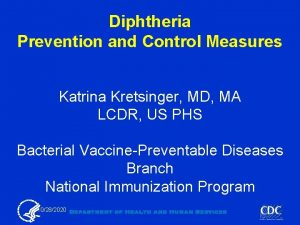The effectiveness of radon preventive and remedial measures

- Slides: 1

The effectiveness of radon preventive and remedial measures in Irish Social housing Stephanie Long and David Fenton Radiological Protection Institute of Ireland (RPII) 3, Clonskeagh Square, Clonskeagh Road, Dublin 14, Ireland 1. Introduction In Ireland, technical guidance in support of the Building Regulations specifies that homes built since July 1998 in High Radon Areas are installed with a radon barrier. A High Radon Area is any 10 -km grid square where 10% or more of all homes are predicted to exceed the National 3 Reference Level of 200 Bq/m. Radon measurement results from local authority homes in High Radon Areas in County Cork have allowed the impact of these regulations to be assessed. Homes exceeding the Reference Level were remediated with the use of an active sump. The results of this remedial work are also presented. 3. Methods Radon concentrations were measured in 338 homes in High Radon Areas in County Cork. 189 of these were built before the 1998 requirement to fit a radon barrier (1969 – 1998). 149 were built after 1998 (1999 – 2007) and should have been fitted with a barrier. These 2 sets of results were used to assess the impact of the requirement to install a radon barrier. 2. Objectives This study had two main objectives: 1. To assess what effect the revised Building Regulations had on radon concentrations in homes built following their introduction 2. To measure the effectiveness of installing an active radon sump in homes with elevated radon concentrations Table 1. Radon concentrations in homes in High Radon Areas in County Cork Build year 1999 -07 1969 -98 No of homes 149 189 78 129 120 272 743 2133 Geometric mean 3 (Bq/m ) Arithmetic mean (Bq/m 3) Maximum 3 (Bq/m ) No of homes > 200 125 homes with elevated radon concentrations were remediated with the installation of an active radon sump. These homes were re-measured and the results compared to the initial measurement to assess the effectiveness of this remedial measure. 3 Bq/m 19 (13%) 62 (33%) A typical external radon sump Table 2. Reduction in radon following installation of an active sump No of homes Initial radon measurements Final radon measurements Remediation efficiency Mean remediation efficiency ± 1 σ 125 200 – 3, 300 Bq/m 3 3 <10 – 389 Bq/m 61 – 99 % 91. 9 ± 7. 5 % 4. Conclusions The requirement to install a radon barrier in homes in High Radon Areas has been beneficial in reducing the exposure of the Irish population to radon gas. On average, this requirement has resulted in a reduction in the radon concentration of about 50%. This requirement has also resulted in a reduction in the number of homes exceeding the reference level and in the maximum radon concentration measured in homes. However, the number of homes exceeding the reference level shows the importance of a radon measurement once a new home has been occupied. In addition, the wide variation in barrier effectiveness shows that greater reductions in radon concentrations can be achieved. Finally, the installation of active sumps to reduce radon concentrations is highly effective resulting in a mean reduction of 92%. Email: slong@rpii. ie

